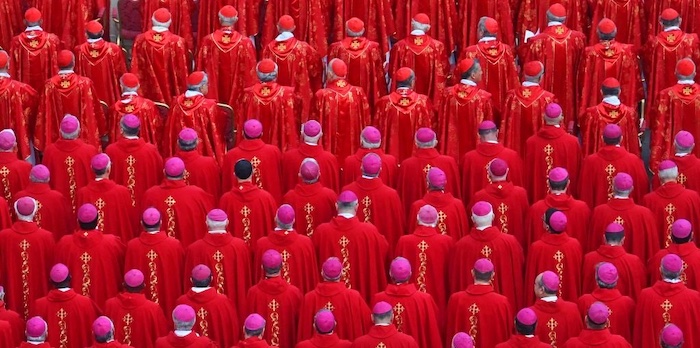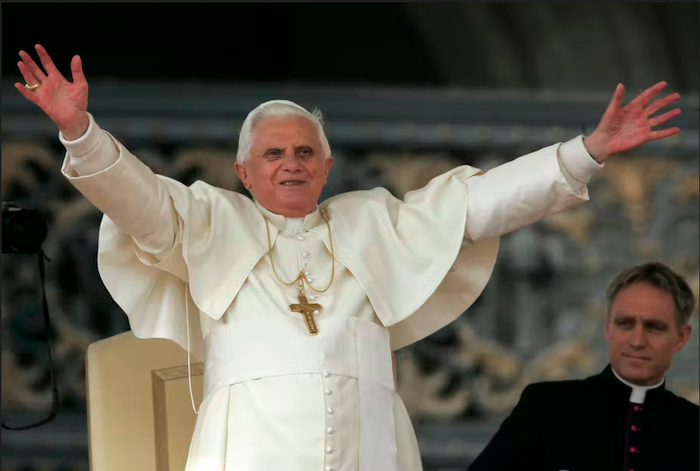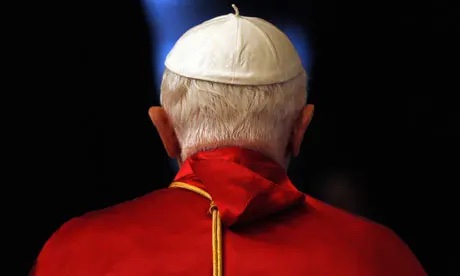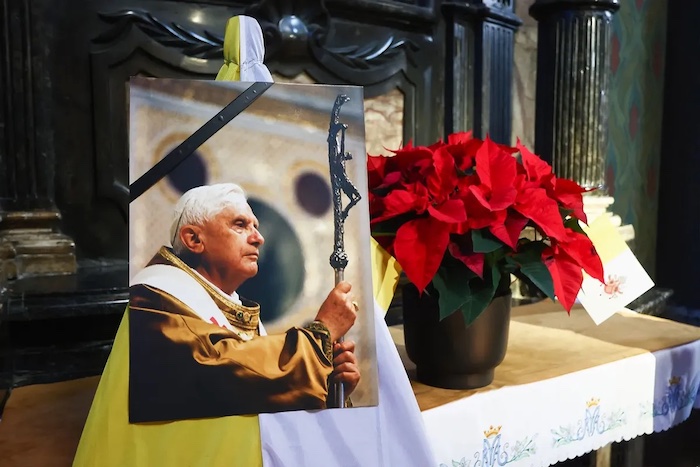
By Jan Lundius
“The Roman curia suffers from spiritual Alzheimer [and] existential schizophrenia; this is the disease of those who live a double life, the fruit of that hypocrisy typical of the mediocre and of a progressive spiritual emptiness which no doctorates or academic titles can fill. […] When appearances, the colour of our clothes and our titles of honour become the primary object in life, [it] leads us to be men and woman of deceit. […] Be careful around those who are rigid. Be careful around Christians – be they laity, priests, bishops – who present themselves as so ‘perfect’. Be careful. There’s no Spirit of God there. They lack the spirit of liberty [..] We are all sinners. But may the Lord not let us be hypocrites. Hypocrites don’t know the meaning of forgiveness, joy and the love of God.”
Pope Francis I
STOCKHOLM, Sweden, Feb 8 2023 (IPS) – When the Pope Emeritus Benedict XIV/Ratzinger died on the last day of 2022 it did not cause much of a stir in the global newsfeed. Maybe a sign that religion has ceased to play a decisive role in modern society Nevertheless, religious hierarchies are still highly influential, not least for the world’s 1, 4 billion baptized Catholics, and a pope’s policies have a bearing not only on morals, but also on political and economic issues. By contrast, there are more Muslims in the world, 1.9 billion, though adherents are not so centrally controlled and supervised as Catholics and hierarchies do not have a comparable influence on global affairs.
When Benedict abdicated in 2013 he retained his papal name, continued to wear the white, papal cassock, adopted the title Pope Emeritus and moved into a monastery in the Vatican Gardens. It must have been a somewhat cumbersome presence for a new, more radical pope, particularly since Benedict became a symbol of traditional values and served as an inspiration for critics of the current papacy.
By the end of his reign, John Paul II was suffering from Parkinson’s disease and Cardinal Ratzinger was in effect running the Vatican and when he was elected Pope in 2005, his closest runner-up was Cardinal Bergoglio from Buenos Aires. What would have happened if Borgoglio, who eventually became Francis I, had been elected? Would he have been able to more effectively deal with clerical sexual abuse and Vatican corruption?
When Joseph Ratzinger became pope, he had for 27 years served John Paul II by heading the Congregation for the Doctrine of the Faith (CDF), investigating and condemning birth control, acceptance of homosexuals, “gender theory” and Liberation Theology, a theological approach with a specific concern for the poor and political liberation for oppressed people.
Under Cardinal Ratzinger the CDF generally overlooked an often shady economic cooperation financing Pope John Paul II’s successful battle against Communism, while covering up clerical sexual abuse and marginalizing “progressive” priests. Several Latin American liberation theologians agreed that John Paul II in several ways was an asset to the Church, though he mistreated clerics who actually believed in Jesus’s declaration that he was chosen to “bring good news to the poor, to proclaim release to the captives and recovery of sight to the blind, to let the oppressed go free.” John Paul II and his “watchdog” Joseph Ratzinger were considered to have “armoured fists hidden in silk gloves.”
Ratzinger censured and silenced a number of leading “liberal” priests, like the Latin American Liberation theologian Leonardo Boff and the American Charles Curran, who supported same sex marriages. Both were defrocked. Under Ratzinger’s CDF rule, several clerics were excommunicated for allowing abortions, like the American nun Margaret McBride, and the ordination of women priests, among them the Argentinian priest Rómulo Braschi and the French priest Roy Bourgeois.
Ratzinger/Benedict wrote 66 books, in which a common theme was Truth, which according to him was “self-sacrificing love”, guided by principles promulgated by the Pope and implemented by the Curia, the administrative body of the Vatican:
“Today, having a clear faith based on the Creed of the Church is often labelled as fundamentalism. Whereas relativism, that is, letting one be tossed here and there, carried about by every wind of doctrine, seems the only attitude that can cope with modern times. We are building a dictatorship of relativism that does not recognize anything as definitive and whose ultimate goal consists solely of one’s own ego and desires.”
A strict adherence to Catholic Doctrine meant bringing the Church back to what Benedict XVI considered as its proper roots. If this alienated some believers, so be it. Numerous times he stated that the Church might well be healthier if it was smaller. A point of view opposed to the one expressed by Francis I:
“Changes need to be made […] Law cannot be kept in a refrigerator. Law accompanies life, and life goes on. Like morals, it is being perfected. Both the Church and society have made important changes over time on issues as slavery and the possession of atomic weapons, moral life is also progressing along the same line. Human thought and development grows and consolidates with the passage of time. Human understanding changes over time, and human consciousness deepens.”
Benedict XVI allowed the issue of human sexuality to overshadow support to environmentalism and human rights. He wanted to “purify the Church” in accordance with rules laid down in the Catechism of the Catholic Church, published in 1992 and written under direction of the then Cardinal Ratzinger. The Catechism might be considered as a counterweight to “relativistic theories seeking to justify religious pluralism, while supporting decline in general moral standards.”
Pope Benedict endeavoured to reintegrate hard-core traditionalists back into the fold, maintaining and strengthening traditional qualms related to sexual conduct and abortion. He declared that modern society had diminished “the morality of sexual love to a matter of personal sentiments, feelings, [and] customs. […], isolating it from its procreative purposes.” Accordingly, “homosexual acts” were in the Catechism described as “violating natural law” and could “under no circumstances be approved.”
Papal condemnation of homosexuality may seem somewhat strange considering that it is generally estimated that the percentage of gay Catholic priests might be 30 – 60, suggesting more homosexual men (active and non-active) within the Catholic priesthood than within society at large.
In 2019, Frédéric Martel’s In the Closet of the Vatican sent shock waves through the Catholic world. Based on years of interviews and collaboration with a vast array of researchers, priests and prostitutes, Martel described the double life of priests and the hypocrisy of homophobic cardinals and bishops living with their young “assistants”. He pinpointed members of the Catholic hierarchy as “closet gays”, revealed how “de-anonymised” data from homosexual dating apps (like Grindl) listed clergy users, described exclusive homosexual coteries within the Vatican, networks of prostitutes serving priests, as well as the anguish of homosexual priests trying to come to terms with their homosexual inclinations.
According to Martel, celibacy is a main reason for homosexuality among Catholic priesthood. For a homosexual youngster a respected male community might serve as a safe haven within a homophobic society.
By burdening homosexuality with guilt, covering up sexual abuse and opaque finances the Vatican has not supported what Benedict proclaimed, namely protect and preach the Truth. Behind the majority of cases of sexual abuse there are priests and bishops who protected aggressors because of their own homosexuality and out of fear that it might be revealed in the event of a scandal. The culture of secrecy needed to maintain silence about the prevalence of homosexuality in the Church, which allowed sexual abuse to be hidden and predators to act without punishment.
Cardinal Robert Sarah stated that “Western homosexual and abortion ideologies” are of “demonic origin” and compared them to “Nazism and Islamic terrorism.” Such opinions did in 2020 not hinder Pope Emeritus Benedict from writing a book together with Sarah – From the Depths of Our Hearts: Priesthood, Celibacy and the Crisis of the Catholic Church. Among injunctions against abortion, safe sex, and women clergy, celibacy was fervently defended as not only “a mere precept of ecclesiastical law, but as a sharing in Jesus’ sacrifice on the Cross and his identity as Bridegroom of the Church.” This in contrast to Francis I, who declared:
“It is time that the Church moves away from questions that divide believers and concentrate on the real issues: the poor, migrants, poverty. We can’t only insist on questions bound up with abortion, homosexual marriage and the use of contraceptive methods. It is not possible … It isn’t necessary to go on talking about it all the time.”
The current pope is not condoning abortion, though does not elevate it above the fight against poverty, climate change and the rights of migrants, which he proclaims to be “pro-life” issues in their own right. In 2021, Francis I stated that “same-sex civil unions are good and helpful to many.” He is of the opinion that Catholic priests ought to be celibate, but adds that this rule is not an unchangeable dogma and “the door is always open” to change. Francis propagates that women ought to be ordained as deacons; allowed to do priestly tasks, except giving absolution, anointing the sick, and celebrate mass and he has recruited women to several crucial administrative positions within the Vatican. Furthermore, he ordered all dioceses to report sexual abuse of minors to the Vatican, while notifying governmental law enforcement to allow for comprehensive investigations and perpetrators being judged by common – and not by canon law.
Just hours after Benedict’s funeral on 5 January Georg Gänswein’s memoir Nothing but the Truth — My Life Beside Benedict XVI, was distributed to the press. Gänswein, who was Benedict’s faithful companion and personal secretary, writes that for the Pope Emeritus the Doctrine of the Faith was the fundament of the Church, while Francis is more inclined to highlight “pastoral care”, i.e. guidance and support focusing on a person’s welfare, social and emotional needs, rather than purely educational ones.
In 2013, Gänswein entered in the service of Benedict XIV. He was professor in Canon Law, fluent in four languages, an able tennis player, excellent downhill skier and had a pilot’s licence. He was also an outspoken conservative and often critical of Francis I.
Shortly before his abdication, Benedict XVI appointed Cardinal Gänswein archbishop and made him Prefect of the Papal Household, deciding who could have an audience with Pope Francis I, while he at the same time was responsible for Benedict’s daily schedule, communications, and private and personal audiences. The Italian edition of the magazine Vanity Fair presented Gänswein on its cover, declaring “being handsome is not a sin” and calling him “the Georg Clooney of the Vatican”. Six years before Donatella Versace used Gänswein as inspiration for her fashion show Priest Chic.
There was an air of vanity and conservatism surrounding the acolytes of Benedict. Gänswein writes that working with both popes, the active one and the ”Emeritus” was a great challenge, not only in terms of work but in terms of style. Benedict XIV was a pope of aesthetics recognising that in a debased world there remain things of beauty, embodied in a Mozart sonata, a Latin mass, an altarpiece, an embroidered cape, or the cut of a cassock. The male-oriented lifestyle magazine Esquire included Pope Benedict in a “best-dressed men list”. Gänswein states that when Pope Francis in 2022 restricted the celebration of the Traditional Latin Mass “I believe it broke Pope Benedict’s heart”.
Pope Francis is now 86, not much time remains for him as sovereign of the Catholic Church. Hopefully he will be able to change the Curia by staffing it with people who share his ambition to reform the Church by navigating away from doctrinal rigidity, vanity and seclusion towards inclusion, tolerance, human rights, poverty eradication and environmentalism.
Complete Article ↪HERE↩!




